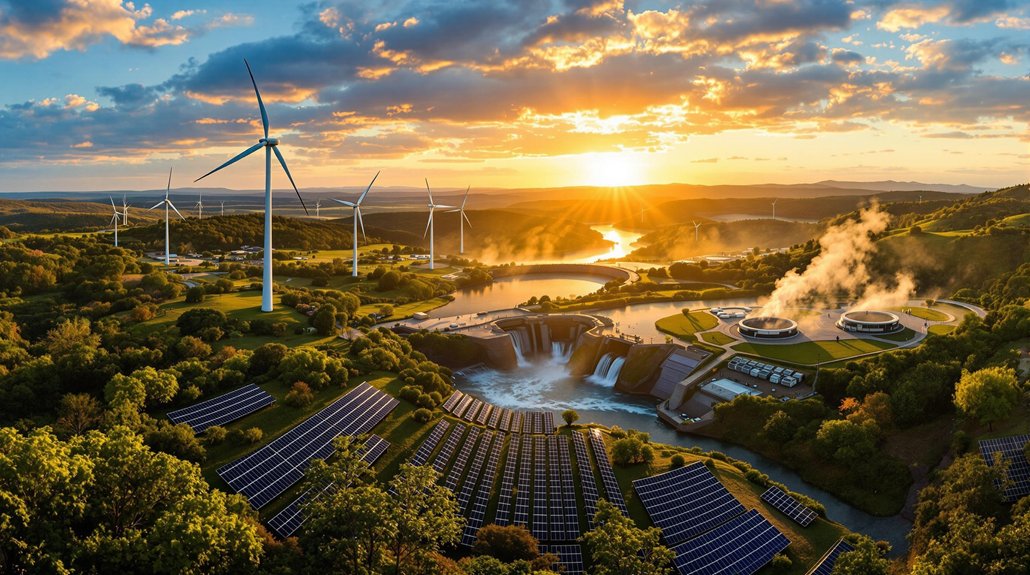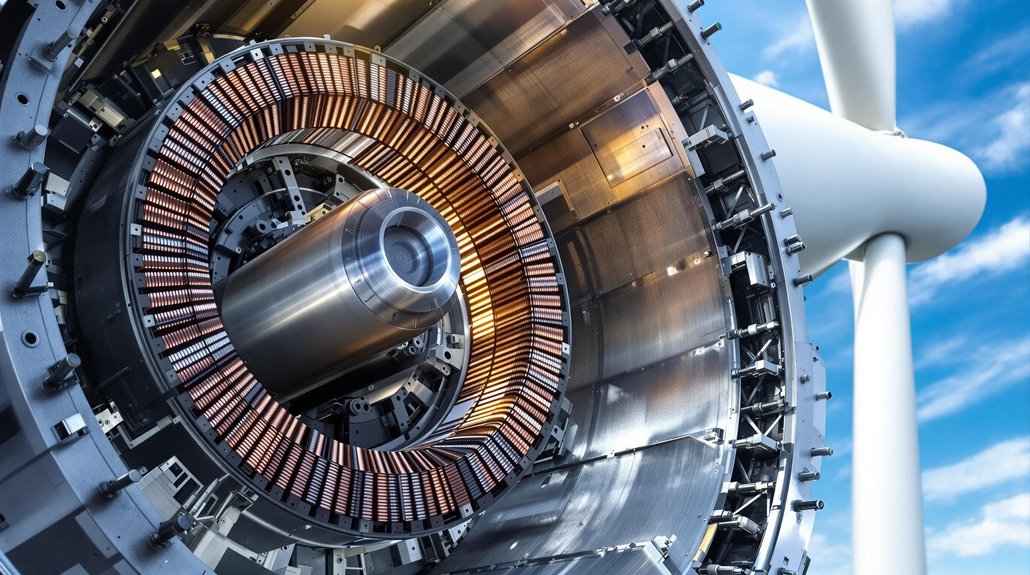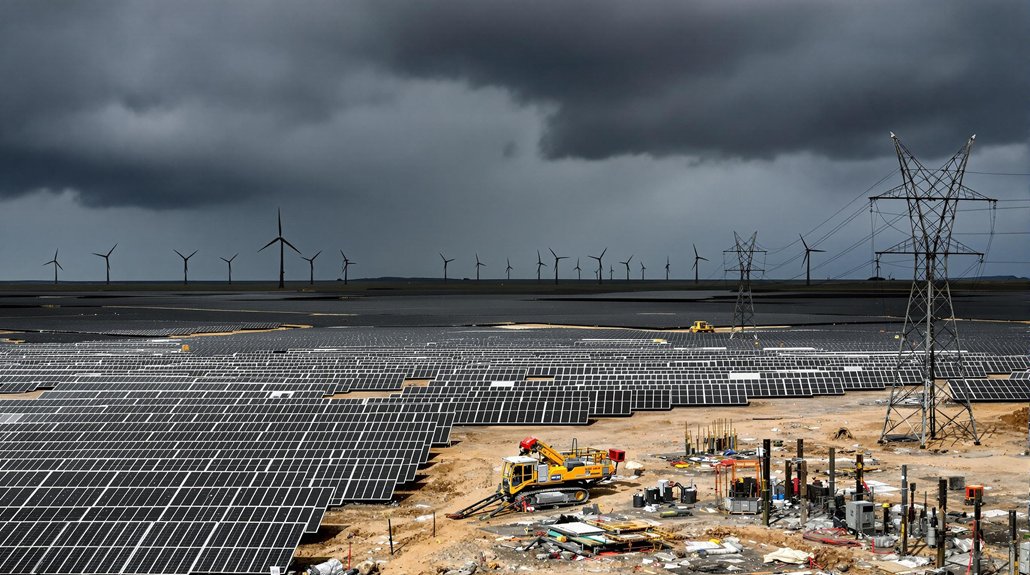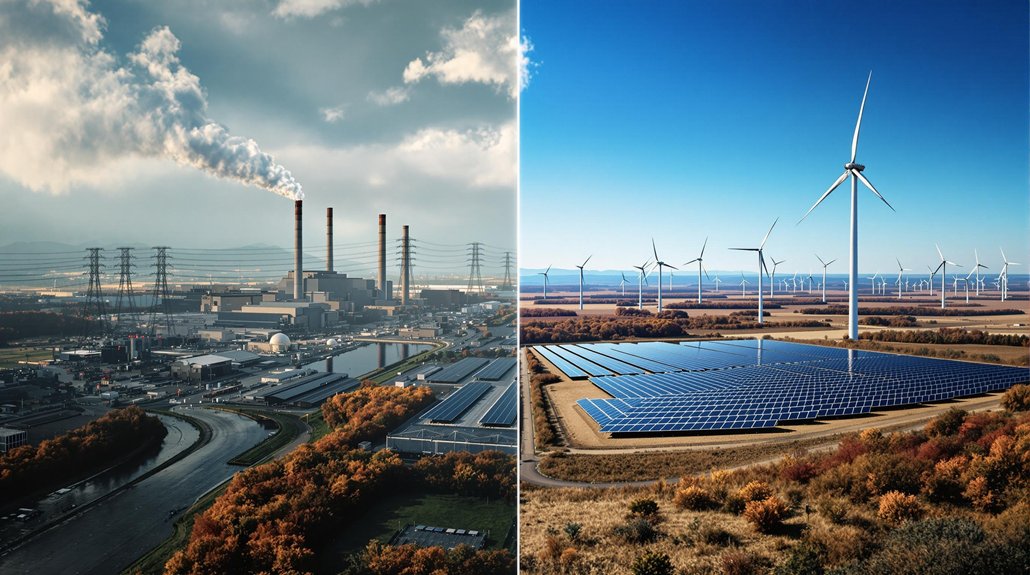Renewable energy sources are transforming how the world produces power. Solar and wind technologies have grown considerably, with costs dropping as capacity increases. Hydropower remains the largest renewable electricity source, providing 16% of global power. Emerging options like geothermal, biomass, and ocean energy are expanding the clean energy portfolio. These sustainable alternatives help combat climate change and address the urgent need to shift from fossil fuels before they’re depleted by 2060.

Why are renewable energy sources becoming increasingly important in today’s world? As global climate concerns grow, the world is turning to clean energy options that don’t harm our planet. Renewable energy comes from natural sources that won’t run out and produces little to no pollution.
Solar energy has seen massive growth, with global capacity reaching 843 GW in 2022. The cost of solar has dropped by 82% between 2010 and 2019, making it more affordable. Solar panels convert sunlight directly into electricity, while concentrated solar systems use mirrors to focus sunlight and generate power. Currently, solar provides 3% of the world’s electricity.
Wind energy is another fast-growing renewable source. Wind turbines capture the wind’s power both on land and at sea. Global wind capacity reached 837 GW in 2021, producing 6% of the world’s electricity. Offshore wind farms are expanding rapidly, with 35 GW installed by 2020.
Hydropower remains the largest renewable electricity source globally. It uses flowing water to spin turbines and generate power. With 1,330 GW of installed capacity, hydropower provides 16% of global electricity and offers valuable energy storage through pumped storage systems.
Geothermal energy taps into Earth’s internal heat. Unlike solar and wind, it provides consistent power 24/7. Global capacity stands at 16 GW, mainly in regions with high geothermal activity.
Biomass energy uses organic materials like wood, crops, and waste as fuel. It accounts for 10% of global energy use and can produce electricity, heat, and transportation fuels.
Ocean energy from waves and tides is still developing but shows great potential. Current global capacity is 535 MW, mostly from tidal systems.
Green hydrogen production is growing rapidly. Made through electrolysis using renewable electricity, it can store energy and help decarbonize industries that are difficult to power with electricity alone. Non-renewable resources such as oil and gas are expected to deplete by 2060, creating urgency for renewable energy adoption. Transitioning to these renewable sources is essential for limiting global warming and creating a more sustainable future.
Frequently Asked Questions
How Much Do Renewable Energy Systems Cost to Install?
Renewable energy installation costs vary widely.
Solar systems cost $10,000-$25,000 for homes and $0.68-$1.13 per watt for utilities.
Wind farms run $1,300-$1,700 per kilowatt for onshore and $2,500-$4,000 for offshore projects.
Geothermal plants range from $2,000-$5,000 per kilowatt.
Hydropower installations cost between $1,000-$5,000 per kilowatt, with small hydro reaching up to $8,000 per kilowatt.
What Incentives Exist for Adopting Renewable Energy Technologies?
Numerous incentives exist for adopting renewable energy technologies.
The federal government offers a 30% tax credit for solar installations through 2032. States provide additional benefits through renewable portfolio standards and net metering policies.
Utility companies offer rebates and on-bill financing. Businesses can utilize power purchase agreements and depreciation deductions.
Homeowners may qualify for property tax exemptions and can sell renewable energy certificates for extra income.
Can Renewable Energy Completely Replace Fossil Fuels?
Technically, renewable energy can replace fossil fuels, but significant challenges remain.
Scientists report full changeover is possible by 2050 with proper planning. Key obstacles include intermittency issues, storage limitations, and high upfront costs.
Some sectors like aviation are harder to convert. Success requires massive infrastructure investments, grid modernization, and policy changes.
Denmark’s progress shows high renewable penetration is achievable, but global coordination is essential for complete replacement.
How Do Weather Patterns Affect Renewable Energy Reliability?
Weather patterns greatly impact renewable energy reliability.
Cloud cover reduces solar panel output by 10-25%. Heat above 25°C decreases solar efficiency by 0.5% per degree.
Wind turbines don’t work below 6-9 mph or above 55 mph. Droughts can cut hydroelectric power by 30% or more.
However, accurate forecasting helps grid operators manage these variations, and combining different renewable sources can offset weather-related variability by 40-60%.
What Are the Environmental Impacts of Manufacturing Renewable Energy Infrastructure?
Manufacturing renewable energy infrastructure has environmental costs.
Solar panel production uses toxic chemicals and energy-intensive processes.
Wind turbines require large amounts of materials that are difficult to recycle.
Battery manufacturing involves mining rare minerals with significant ecological impacts.
Hydropower projects flood land, disrupt ecosystems, and produce methane emissions.
Despite these impacts, these technologies generally produce less pollution over their lifetime than fossil fuel alternatives.









